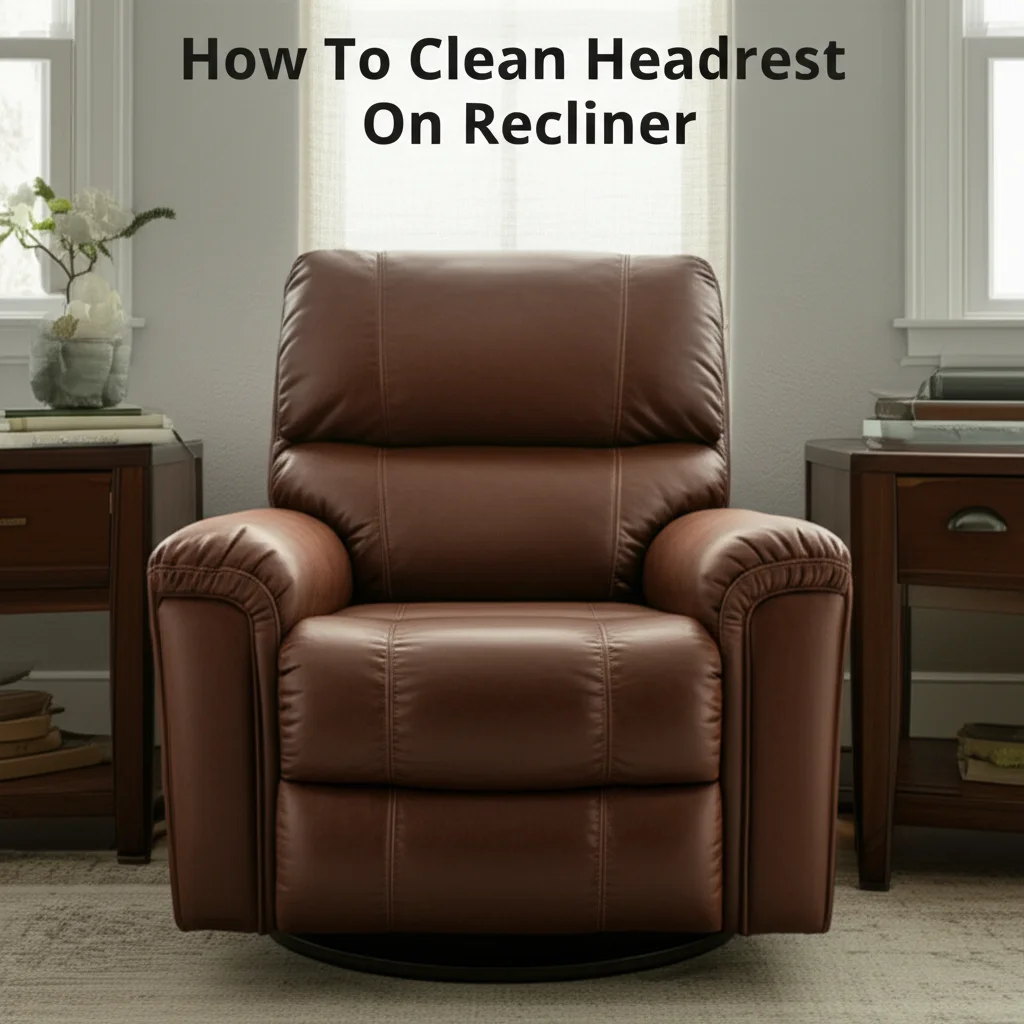· Kianna Connelly · Home Improvement - Stain Removal · 19 min read
How To Get Blood Out Of A Chair

Effective Ways to Get Blood Out of a Chair
Life happens, and sometimes unexpected accidents leave unwanted marks on our furniture. A blood stain on your favorite chair can feel like a major disaster. Many people wonder how to get blood out of a chair without damaging the material. This guide will walk you through the proper steps to tackle these stains. We will cover methods for different chair types and stain ages. You can restore your chair’s appearance with the right approach and supplies. This article helps you understand the tools you need. It also explains the specific techniques for various situations.
Takeaway
Removing blood from a chair requires quick action and the right technique.
- Always test cleaning solutions on an hidden spot first.
- Use cold water for fresh blood stains; heat sets the stain.
- Blot, do not rub, to prevent spreading the stain deeper.
- Choose cleaning agents specific to your chair’s material.
- Consider professional help for stubborn or old stains.
When blood lands on a chair, act quickly. Blot fresh stains with a clean cloth and cold water. For dried blood, pre-treat with a paste of baking soda or an enzyme cleaner. Always test any solution on an inconspicuous area first. This prevents damage to the chair material.
The Urgency of Treating Blood Stains Quickly
Dealing with a blood stain on your chair requires immediate action. Fresh blood is much easier to remove than dried blood. Blood contains proteins and hemoglobin. These components can bond quickly with chair fibers. Once these proteins dry, they become more difficult to break down and lift. Acting fast prevents the stain from setting deeply into the material.
As soon as you notice a blood spill, gather your cleaning supplies. Time is truly of the essence in these situations. Do not let the stain sit for hours or days. The longer it remains, the more it adheres to the fabric or surface. Swift action significantly improves your chances of complete stain removal.
Understanding Blood and Chair Material Interaction
Different chair materials react differently to blood. Fabric chairs, like those made of cotton, polyester, or linen, absorb liquids quickly. This makes immediate treatment critical. Blood can wick deep into the fibers. Leather chairs are less absorbent, but blood can still dry on the surface. It can also seep into pores or seams. Understanding your chair’s material helps you choose the best cleaning method.
Always identify the fabric or material of your chair before starting. Check the care tag if available. Some delicate fabrics may require professional cleaning. Others can handle more robust solutions. Knowing your material prevents accidental damage or discoloration.
Essential Tools and Solutions for Blood Stain Removal
Having the right cleaning agents and tools makes the blood removal process easier. You do not need many specialized items. Most are common household products. These supplies help you effectively tackle both fresh and dried blood stains. Prepare your toolkit before you begin cleaning.
Basic Cleaning Supplies
You will need several absorbent materials. Clean white cloths or paper towels are good choices. Avoid colored cloths, as their dyes might transfer to your chair. A spray bottle can help apply liquids evenly. A soft brush might be useful for working solutions into stubborn areas.
Here is a list of common household items that are effective:
- Cold Water: This is crucial for fresh blood. Hot water cooks the protein, setting the stain.
- Hydrogen Peroxide: A common antiseptic, it works wonders on blood. It causes a bubbling action that lifts the stain. Use it on light-colored or white fabrics. Test it on dark fabrics first, as it can cause bleaching.
- Dish Soap/Laundry Detergent: Mild soaps help break down the blood proteins. They are safe for most materials.
- Salt: Salt mixed with cold water can create an abrasive paste. This helps lift fresh stains.
- Baking Soda: Similar to salt, baking soda forms a paste. It is a gentle abrasive and odor absorber.
- Meat Tenderizer: Unseasoned meat tenderizer contains enzymes. These enzymes break down blood proteins.
- Enzyme Cleaner: These cleaners are designed to break down organic stains. Pet stain removers often contain enzymes.
Always have these items ready when an accident happens. Quick access to these solutions improves your stain removal success rate.
Tackling Fresh Blood Stains on Fabric Chairs
Fresh blood stains are the easiest to manage. Your speed in addressing the stain directly impacts the outcome. Resist the urge to panic. Follow these steps carefully to effectively get blood out of a chair.
Step-by-Step for Fresh Stains
- Blot, Don’t Rub: The very first action is to blot the excess blood. Use a clean white cloth or paper towel. Press firmly on the stain. Do not rub the blood. Rubbing pushes the blood deeper into the fibers and spreads it. Continue blotting until no more blood transfers to your cloth.
- Apply Cold Water: Dampen another clean cloth with cold water. Gently blot the stain area. Work from the outside of the stain inward. This prevents the stain from spreading outwards. Keep rinsing your cloth and blotting until the water runs clear.
- Choose a Cleaning Agent:
- For General Fabrics (Cotton, Polyester): Mix a small amount of mild dish soap or laundry detergent with cold water. You can also use a mixture of salt and cold water to form a paste. Apply the paste directly to the stain. Let it sit for 10-15 minutes.
- For Lighter Fabrics/White Chairs: Hydrogen peroxide is highly effective. Dab a small amount onto the stain with a cotton ball or clean cloth. You will see it fizz as it reacts with the blood. This bubbling action helps lift the stain.
- Rinse and Repeat: After the cleaning agent has worked, blot the area with a clean, damp cloth. Use only cold water. Continue blotting until all traces of the cleaning solution are gone. If the stain remains, repeat the process. You may need to apply the cleaning agent and blot several times.
- Air Dry: Once the stain is gone, allow the area to air dry completely. Avoid using heat, such as a hair dryer. Heat can set any remaining traces of the stain. You can gently fan the area or use a cold setting on a hair dryer for quicker drying.
For similar tips on cleaning blood from other fabric items, you can explore guides on how to clean blood off sheets. The principles of cold water and blotting apply broadly to various fabrics. Remember, patience and persistence are key.
Removing Dried Blood Stains: A Persistent Challenge
Dried blood stains present a greater challenge than fresh ones. The blood proteins have bonded with the chair fibers. This makes them much harder to dislodge. However, it is still possible to get blood out of a chair, even if it has dried. You will need stronger methods and more patience.
Strategies for Dried Blood
- Scrape Off Excess: Gently scrape off any crusted, dried blood. Use a dull knife, the edge of a credit card, or a spoon. Be careful not to damage the chair fabric. This step removes the top layer of the stain.
- Soften the Stain: Dampen a clean cloth with cold water. Place it over the dried blood stain. Let it sit for 30 minutes to an hour. This helps rehydrate and soften the dried blood. The stain will become more receptive to cleaning agents.
- Apply Enzyme Cleaner or Paste:
- Enzyme Cleaner: These cleaners contain enzymes that break down organic matter like blood. Spray the enzyme cleaner directly onto the rehydrated stain. Follow the product instructions for dwell time. Enzyme cleaners are often effective on tough stains, similar to what you might use if you need to remove old blood stains from a mattress.
- Baking Soda Paste: Mix baking soda with enough cold water to form a thick paste. Apply this paste generously over the dried blood stain. Allow it to sit for several hours or even overnight. The baking soda helps draw out the stain.
- Hydrogen Peroxide (for light fabrics): If the fabric is light-colored and bleach-safe, hydrogen peroxide can be used. Apply a small amount and let it fizz. Blot away the residue. Be cautious, as hydrogen peroxide can lighten some fabrics.
- Meat Tenderizer Paste: Create a paste using unseasoned meat tenderizer powder and a few drops of cold water. Apply this paste to the stain. Let it sit for 30-60 minutes. The enzymes in the tenderizer break down blood proteins.
- Blot and Rinse: After the chosen treatment has had time to work, blot the area with a clean, damp cloth. Use cold water to rinse. Continue blotting until the stain lifts and no residue remains. You may need to repeat the application and blotting process multiple times.
- Final Rinse and Dry: Once the stain is gone, blot the area thoroughly with clean, cold water. This removes all cleaning solution residue. Allow the chair to air dry completely. Ensure the area is well-ventilated.
Removing dried blood stains requires patience and consistency. Do not get discouraged if the stain does not disappear after the first attempt. Repeating the process often yields better results.
Special Care for Different Chair Materials
Chairs come in many materials. Each type requires a specific approach for blood stain removal. What works for fabric might harm leather. Always identify your chair’s material before starting. This prevents irreversible damage.
Leather Chairs
Cleaning blood from a leather chair needs a gentle touch. Leather is a delicate material. Harsh chemicals can dry it out or cause discoloration.
- Fresh Blood: Immediately blot the blood with a clean, dry cloth. Do not rub. Dampen a soft cloth with cold water and a tiny drop of mild dish soap. Gently wipe the stain. Follow up with a clean, damp cloth to remove soap residue. Dry with a clean, soft towel. Apply a leather conditioner afterwards to maintain moisture. You can find more specific leather cleaning tips if you need to clean a leather chair in general.
- Dried Blood: Rehydrate the stain first. Place a cold, damp cloth over the dried blood for 10-15 minutes. This softens it. Then, gently scrape off any loosened bits with a dull edge. Mix a small amount of leather cleaner (or mild soap) with cold water. Apply with a soft cloth. Blot, do not rub. Rinse with a clean, damp cloth and dry. Use leather conditioner.
Microfiber Chairs
Microfiber is a synthetic fabric known for its durability. It often has a “W” or “S/W” cleaning code, meaning water-based or solvent-based cleaners can be used.
- Fresh Blood: Blot immediately with a clean, white cloth. Mix a small amount of mild dish soap with cold water. Dip a clean cloth into the solution and wring it out well. Blot the stain, working from the outside in. Rinse by blotting with a clean, cold-water-dampened cloth.
- Dried Blood: Lightly dampen the dried stain with cold water. Apply a paste of baking soda and cold water. Let it sit for 30 minutes to an hour. Gently blot the paste and stain away with a clean, damp cloth. You may also use an enzyme cleaner designed for upholstery. For general care, learning how to clean a microfiber chair can be very helpful.
Mesh Chairs
Mesh chairs, common in offices, have a woven, breathable material. These can be tricky due to their open weave.
- Fresh Blood: Blot the stain immediately with a clean, cold-water-dampened cloth. Press gently to absorb the blood. Do not push it through the mesh.
- Dried Blood: Use a soft brush or toothbrush to gently loosen any dried blood particles. Mix mild soap with cold water. Use a cloth dipped in the solution to dab the stain. Avoid soaking the mesh. Rinse by dabbing with a clean, cold-water-dampened cloth. You might find more tips on how to clean a mesh chair for overall maintenance.
Polyester and Other Fabric Chairs
Polyester is a common, durable synthetic fabric. Other fabrics like cotton or linen require similar care. Many of these principles are also useful for general fabric cleaning, such as how to clean a polyester chair or how to clean a fabric office chair.
- Fresh Blood: Blot away excess blood with a clean, cold-water-dampened cloth. Apply a paste of salt and cold water or a solution of mild dish soap and cold water. Let it sit for 10-15 minutes. Blot clean with cold water.
- Dried Blood: Apply hydrogen peroxide (test first on an inconspicuous area) or an enzyme cleaner. Let it sit for a few minutes. Blot thoroughly with a clean, cold-water-dampened cloth until the stain is gone. Repeat if necessary.
Always perform a patch test on an inconspicuous area of your chair. This is crucial before applying any cleaning solution to the main stain. Different dyes and finishes can react unexpectedly.
What Not to Do: Common Mistakes to Avoid
When you are trying to remove blood from a chair, certain actions can make the stain worse. Avoiding these common mistakes helps ensure successful cleaning. It also protects your chair from damage. Being aware of these pitfalls is just as important as knowing the right steps.
Mistakes That Set Stains
- Using Hot Water: This is perhaps the most critical rule. Hot water causes the proteins in blood to coagulate. This essentially cooks the blood into the fabric fibers. Once the protein sets, the stain becomes almost impossible to remove completely. Always use cold water for blood stains.
- Rubbing the Stain: Your instinct might be to scrub the stain away. However, rubbing spreads the blood. It also pushes the stain deeper into the fabric. This makes it larger and more embedded. Always blot the stain gently with a clean cloth. Blotting lifts the stain out of the fibers.
- Using Bleach on Non-White Fabrics: Bleach is a powerful stain remover. It can effectively remove blood from white fabrics. However, bleach will permanently damage and discolor colored fabrics. It can also weaken fabric fibers over time. Stick to color-safe alternatives like hydrogen peroxide for lighter fabrics or enzyme cleaners.
- Applying Too Much Solution: Over-wetting the chair material can cause new problems. Excess moisture can lead to mold or mildew growth. It can also damage the chair’s internal padding or wood frame. Apply cleaning solutions sparingly. Aim to dampen the stain, not soak the entire area.
- Not Testing Solutions First: Every chair fabric reacts differently to cleaning agents. Skipping the patch test is a common mistake. Always apply a small amount of your chosen cleaner to an inconspicuous area. Wait a few minutes to observe any adverse reactions like discoloration or damage.
- Using Abrasive Tools on Delicate Fabrics: While a soft brush can help with some materials, harsh scrubbing brushes or abrasive pads can damage delicate fabrics. They can fray fibers or create pilling. Use soft cloths or sponges, and gentle blotting motions.
- Drying with Heat: Just like hot water, applying heat to a stained area can set any remaining blood. Once you have cleaned the stain, allow the chair to air dry naturally. If you must speed up drying, use a fan or the cool setting on a hairdryer.
By avoiding these common mistakes, you increase your chances of successful blood stain removal. You also protect your chair’s longevity and appearance. Patience and adherence to proper techniques are your best allies.
Advanced Techniques and Professional Help
Sometimes, despite your best efforts, a blood stain might stubbornly remain. This is especially true for very old stains or delicate, expensive materials. Knowing when to escalate your cleaning efforts or call in professionals is important. These advanced steps can save your chair.
Specialized Stain Removers
If household remedies do not work, consider specialized stain removers. Look for products specifically designed for blood or protein-based stains. These often contain stronger enzymes or unique formulations. Always read the label carefully. Ensure the product is safe for your chair’s specific material. Follow the instructions precisely.
For example, some upholstery cleaners are formulated to tackle tough organic stains. They might come as sprays, foams, or powders. Always test these products in a hidden spot first. This checks for colorfastness or damage.
Steaming (Use with Caution)
Steaming can help loosen dried blood from some fabric types. The heat and moisture can rehydrate the stain. However, use extreme caution. Too much heat can set the stain. Steam is best used sparingly and quickly. Hold the steamer a few inches away from the stain. Blot immediately with a clean, cold-water-dampened cloth. This method is generally not recommended for leather or very delicate fabrics.
When to Call a Professional Cleaner
There are clear signs it is time to seek expert help:
- Large or Deep Stains: If the blood stain is extensive or has deeply saturated the chair’s padding, a professional has the equipment to extract it.
- Delicate or Antique Materials: Vintage or very delicate fabrics (like silk, velvet) can be easily damaged by DIY cleaning. Professionals have specialized knowledge and tools for these materials.
- Persisting Stains: If you have tried several methods and the stain remains, a professional cleaner has access to stronger, commercial-grade solutions. They also have industrial extraction machines.
- Unknown Fabric Type: If you are unsure about your chair’s material, it is safer to consult a professional. They can identify the fabric and recommend the best treatment.
- Odor Remains: Sometimes, even if the visible stain is gone, a faint odor might linger. Professionals can use deodorizing treatments to eliminate smells.
Professional upholstery cleaners have experience with various stain types and materials. They often offer guarantees for their work. While it incurs a cost, it can save you from damaging a valuable piece of furniture. They can often do things you can’t, like clean blood off walls or other surfaces without damaging them.
Preventing Future Stains and Maintaining Your Chair
Prevention is always better than cure. While accidents happen, you can take steps to minimize the risk of future blood stains. Regular maintenance also keeps your chair looking its best. These practices can save you time and effort in the long run.
Tips for Preventing Stains
- Use Slipcovers or Throws: For chairs that see heavy use or are in areas prone to spills, consider using a washable slipcover or a decorative throw blanket. These act as a protective barrier. They can be easily removed and cleaned.
- Be Mindful During Activities: If you are performing activities that might involve cuts or scrapes (e.g., crafting, minor first aid), cover the chair with a old towel or sheet.
- Educate Household Members: Ensure everyone in the house knows to report spills immediately. Emphasize the importance of quick action for blood stains.
- Avoid Eating/Drinking on Delicate Chairs: While sometimes unavoidable, try to keep food and drinks away from very expensive or hard-to-clean chairs.
- Regular Cleaning: Keeping your chair generally clean can help. Dust and dirt can make stains harder to remove. Vacuum fabric chairs regularly. Wipe down leather or mesh chairs. This general care helps prepare your chair for any unexpected accidents. You can also explore specific guides on how to clean various chair types, such as how to clean a gaming chair or how to clean a secretlab chair, for comprehensive maintenance.
General Chair Maintenance
Regular maintenance keeps your chair in good condition and helps prevent stains from setting.
- Vacuuming: For fabric chairs, vacuum regularly using an upholstery attachment. This removes dust, crumbs, and loose debris. It prevents them from settling into the fibers and becoming stains.
- Spot Cleaning Small Spills: Address any spills, no matter how small, as soon as they happen. This prevents them from becoming larger, set-in stains.
- Professional Cleaning Schedules: Consider professional deep cleaning for your chairs every 12-24 months. This removes accumulated dirt and grime. It also refreshes the fabric. Professionals can also apply fabric protectors. These protectors create a barrier against future spills.
By combining preventative measures with regular cleaning, you can significantly extend the life and beauty of your chairs. Dealing with a blood stain effectively means not just cleaning it, but also ensuring your chair is prepared for future challenges.
FAQ Section
How long can a blood stain sit before it’s impossible to remove from a chair?
Fresh blood is easiest to remove. A blood stain becomes significantly harder to remove once it dries. Proteins in blood bond with chair fibers. This process can start within minutes to a few hours. While old stains are challenging, they are not always impossible. Prompt action greatly increases success.
Can I use bleach on any chair fabric to remove blood?
No, you should not use bleach on all chair fabrics. Bleach can cause permanent discoloration and damage to colored fabrics. It also weakens fibers. Use bleach only on white, bleach-safe fabrics. Always test hydrogen peroxide or an enzyme cleaner first on an hidden area.
What is the best homemade solution for blood stains on fabric chairs?
For fresh blood on fabric chairs, a mixture of cold water and mild dish soap is highly effective. Alternatively, a paste made from salt and cold water works well. For dried stains, a paste of baking soda and cold water, or hydrogen peroxide on light fabrics, are good homemade options.
Is hydrogen peroxide safe for all chair materials?
Hydrogen peroxide is very effective on blood stains, especially on light-colored or white fabrics. However, it can have a bleaching effect. Always test hydrogen peroxide on an inconspicuous area first. Avoid using it on dark or delicate fabrics without a prior patch test to prevent damage.
When should I consider calling a professional cleaner for a blood-stained chair?
You should call a professional cleaner for large, deeply set, or old blood stains. Also, consult professionals for delicate, antique, or expensive chair materials. If you are unsure of the fabric type or if DIY methods have failed, professional help is recommended to prevent further damage.
How can I protect my chair from future blood stains?
Protect your chair from future blood stains by using washable slipcovers or throw blankets. Be mindful when engaging in activities that might cause spills. Always cover the chair if there’s a risk of blood. Address any small spills immediately to prevent them from setting.
Conclusion
A blood stain on your chair can be startling. But with the right knowledge and tools, you can effectively get blood out of a chair. The key is acting quickly and choosing the right method for your specific chair material. Remember, cold water is your best friend for fresh stains. Avoid hot water at all costs. Gentle blotting motions are always better than rubbing.
From delicate leather to durable polyester, each material needs a tailored approach. If you face a stubborn, dried stain or have a valuable piece, do not hesitate to seek professional help. By following these guidelines, you can restore your chair to its former glory. Keep your living space clean and stain-free. A little effort goes a long way in maintaining your home essentials.





